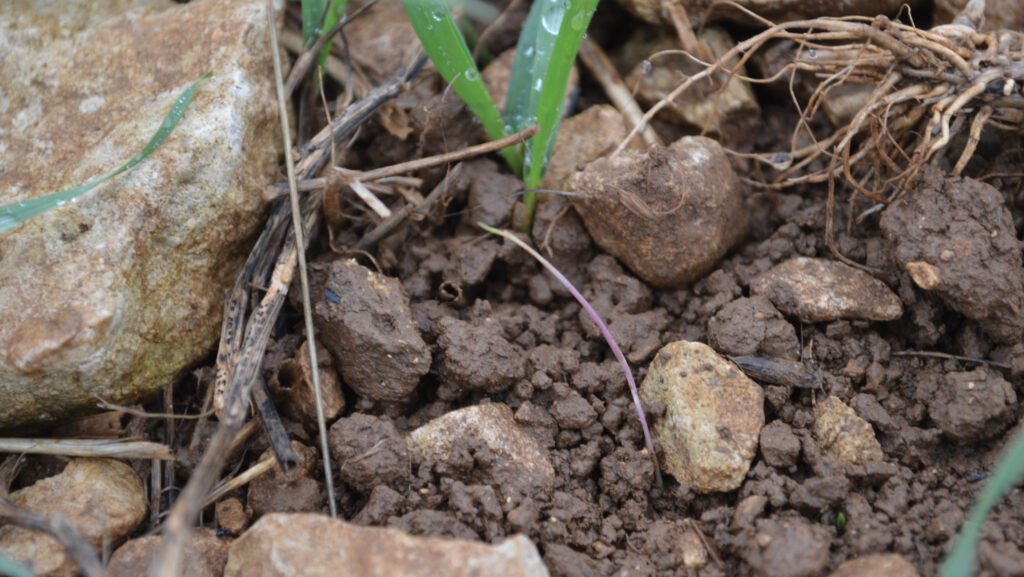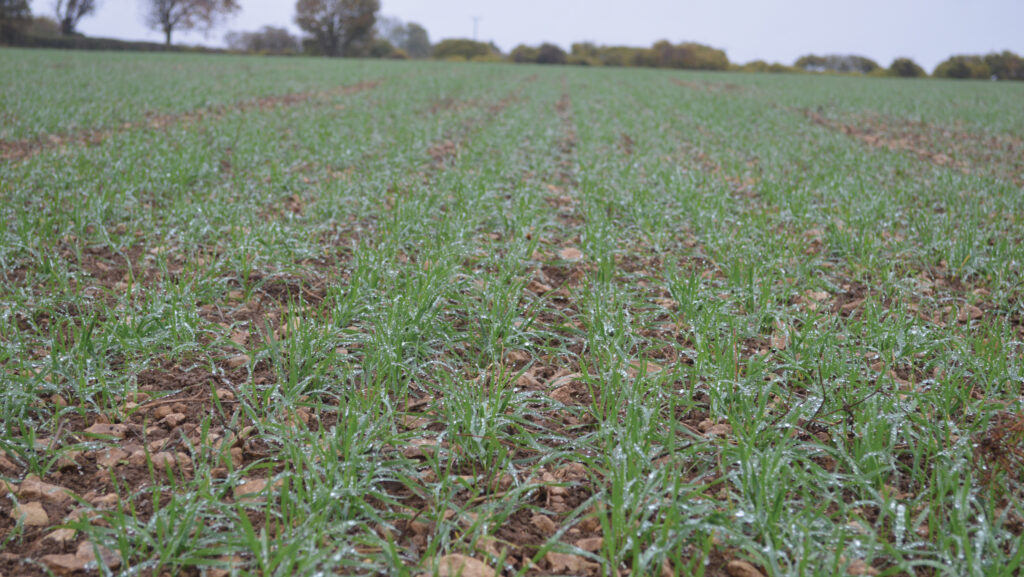How a farmer is planning weed control without flufenacet
 Ollie Stobo (right) with Agrii agronomist Ed Lammie © David Jones
Ollie Stobo (right) with Agrii agronomist Ed Lammie © David Jones Oxfordshire wheat grower Ollie Stobo has been using new autumn herbicide Fundatis to control his “medium” levels of blackgrass and some troublesome broad-leaved weeds.
He has trialled FMC’s product across some of his winter wheat land, where blackgrass is a persistent but manageable problem on his predominately light Cotswold limestone brash soils.
See also: Wheat growers urged to consider third weed spray in dry autumn
Small young blackgrass shoots were bleached a pinkish colour as the product – which brings a new mode of action to the UK cereals herbicide market – leads to disruption of green chlorophyll pigment production in susceptible weeds, leading to the colouration.

The characteristic pink colour of blackgrass after treatment with Fundatis © David Jones
Ollie Stobo’s current winter wheat herbicide programme
- Pre-emergence spray Cinmethylin + picolinafen (Luxigard Opti)
- Peri-emergence spray Flufenacet + diflufenican (Liberator or similar)
Ollie is also mindful of the likely banning of the widely used autumn residual herbicide flufenacet in the UK, so is already formulating a future blackgrass control strategy without it.
“Blackgrass is not a severe issue, but it’s always there in the background,” he says. “We have not ploughed for about six or seven years now, using min-till instead to save time and cost.”
Last season, he took part in an FMC trial with the new herbicide, applying it to a 24m-wide strip of winter wheat. Pleased with the results, he has expanded its use to 8ha this autumn.
“It looked better than I was expecting last year, so we wanted to see how it performed on a larger scale,” he says.
Fundatis contains bixlozone, also known as Isoflex, which brings an alternative for UK cereal growers at a time when grassweed resistance to herbicides is a growing concern.
It also contains beflubutamid which is new to the UK but has been widely used for many years in European cereal crops.
Ollie grows nearly 100ha of Group 1 and 2 milling winter wheats, including varieties such as Skyfall, Palladium and Extase, at Oaklands Farm between Woodstock and Witney, with average yields of 7.5-8t/ha.
He has a four-year arable rotation of two winter wheat crops followed by two spring crops of barley and then oats. He says the two-year spring cropping break has helped with blackgrass control.
Cover crops are grown before the spring cereal crops and are grazed by a neighbour’s sheep to improve soil organic matter.
Along with his agronomist Ed Lammie from Agrii, Ollie has been devising a new autumn weed control strategy to deliver effective blackgrass control and prepare for a flufenacet-free future.
The new strategy, used over 8ha this autumn, is to keep the same pre-emergence spray and replace the one at peri-emergence – or very early emergence – with Fundatis.
The new herbicide will not be used as a standalone product but in a herbicide sequence helping to replace flufenacet.
Ed says: “We have been using Fundatis alongside our standard programme to see how it fits.
“The aim is to be ready if and when flufenacet disappears, and we are also looking to nail grassweed problems in the autumn and not have to come back in the spring.”
He has been pleased with the results from the Fundatis trial last year and the level of weed control achieved this autumn on the 8ha block.
“Flufenacet is a very cost-effective product, and nothing will replace it on a like-for-like cost basis.
“But the performance of Fundatis suggests it could represent good value, especially if it helps maintain weed control and avoids yield losses,” he says.
Ed has been encouraged by the performance of the new herbicide.
It has shown good control of medium infestations of blackgrass and controls broad-leaved weeds such as groundsel and speedwell, which can often slip through an autumn herbicide programme.

Palladium winter wheat largely clear of blackgrass © David Jones
He expects it will become increasingly valuable for a number of his farming clients in southern England if flufenacet gets banned in the UK.
“I will use it in low to medium blackgrass programmes or on farms where other grassweeds and broad-leaved weeds are the main target,” he says.
The 8ha of winter wheat treated with the new herbicide was drilled in the last week of September. Upon inspection a few weeks later, the field was looking clean.
For Ollie, this was a good result.
The management of autumn grass and broad-leaved weeds is key to productivity, as he runs the 200ha arable farm on his own, producing good yields of milling wheat on relatively low fertility, light brashy drought-prone land.
By integrating Fundatis into his existing weed control strategy, he is looking to understand how to get the best results across different field conditions and how he will use it in the future.
“On this farm, the new herbicide looks as if it will fit well into the farm programme going forward,” Ollie says.
The introduction of Fundatis comes at a time when grassweed resistance to herbicides is an increasing concern.
It arrives three years after BASF’s cinmethylin (Luximo) – also with a new mode of action – arrived on the market for autumn 2022.
With many farms dependent on a limited number of herbicide active ingredients, these two recent additions will allow greater flexibility in spray programmes and help extend the effectiveness of other approved chemistry.
Herbicide actives
- Fundatis Bixlozone (Isoflex) + beflubutamid
- Luxinum Plus Cinmethylin (Luximo)
- Luxigard Opti Cinmethylin + picolinafen
- Liberator Flufenacet + diflufenican
Fundatis
Agrochemicals giant FMC launched its Fundatis residual herbicide for this autumn, for use on winter wheat and winter barley to control grass and broad-leaved weeds.
The product contains a new active, bixlozone, also known as Isoflex, which introduces a new herbicide mode-of-action to the UK cereals market, and also includes beflubutamid which has been used in cereal crops in the EU.
Bixlozone comes from the same chemical family as clomazone (sold by FMC as Centium) – which is used as a herbicide in oilseed rape and some other non-cereal crops.
It has proved a very stable active with few signs of weed resistance developing.
Beflubutamid, sold by FMC as Beflex as a cereal herbicide in continental Europe, comes from the same chemical family as the widely used cereal herbicide active diflufenican.
Robbie Jamie, commercial technical manager for FMC South, says Fundatis gives arable growers a new option for the control of grassweeds and often troublesome broad-leaved weeds such as groundsel and speedwell.
”It introduces a new mode of action for cereal growers, giving them a new tool in the armoury for grassweed control alongside a wide spectrum of broad-leaved weed activity,” he says.
The product can be used as a pre-emergence herbicide for winter wheat and winter barley, and early post-emergence for winter wheat.
The launch of Fundatis comes at a time when the widely used residual herbicide flufenacet, a component in many winter cereal herbicide programmes, is predicted to be restricted in the UK.
The EU has agreed to ban flufenacet, and while the timeline remains unclear, the UK is seen as likely to follow suit.

